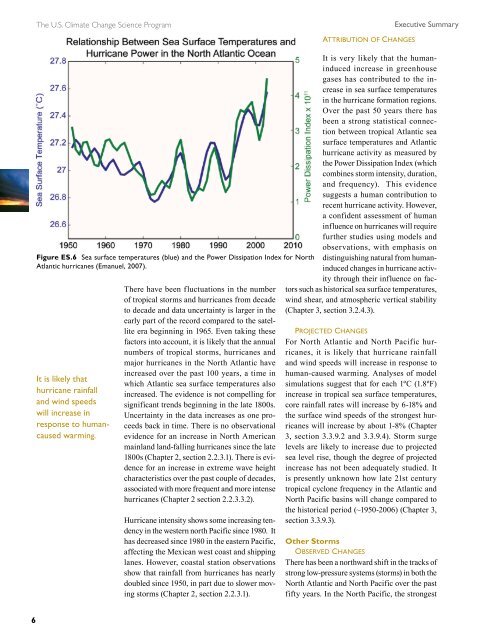Weather and Climate Extremes in a Changing Climate. Regions of ...
Weather and Climate Extremes in a Changing Climate. Regions of ...
Weather and Climate Extremes in a Changing Climate. Regions of ...
You also want an ePaper? Increase the reach of your titles
YUMPU automatically turns print PDFs into web optimized ePapers that Google loves.
6<br />
The U.S. <strong>Climate</strong> Change Science Program Executive Summary<br />
Figure ES.6 Sea surface temperatures (blue) <strong>and</strong> the Power Dissipation Index for North<br />
Atlantic hurricanes (Emanuel, 2007).<br />
It is likely that<br />
hurricane ra<strong>in</strong>fall<br />
<strong>and</strong> w<strong>in</strong>d speeds<br />
will <strong>in</strong>crease <strong>in</strong><br />
response to humancaused<br />
warm<strong>in</strong>g.<br />
There have been fluctuations <strong>in</strong> the number<br />
<strong>of</strong> tropical storms <strong>and</strong> hurricanes from decade<br />
to decade <strong>and</strong> data uncerta<strong>in</strong>ty is larger <strong>in</strong> the<br />
early part <strong>of</strong> the record compared to the satellite<br />
era beg<strong>in</strong>n<strong>in</strong>g <strong>in</strong> 1965. Even tak<strong>in</strong>g these<br />
factors <strong>in</strong>to account, it is likely that the annual<br />
numbers <strong>of</strong> tropical storms, hurricanes <strong>and</strong><br />
major hurricanes <strong>in</strong> the North Atlantic have<br />
<strong>in</strong>creased over the past 100 years, a time <strong>in</strong><br />
which Atlantic sea surface temperatures also<br />
<strong>in</strong>creased. The evidence is not compell<strong>in</strong>g for<br />
significant trends beg<strong>in</strong>n<strong>in</strong>g <strong>in</strong> the late 1800s.<br />
Uncerta<strong>in</strong>ty <strong>in</strong> the data <strong>in</strong>creases as one proceeds<br />
back <strong>in</strong> time. There is no observational<br />
evidence for an <strong>in</strong>crease <strong>in</strong> North American<br />
ma<strong>in</strong>l<strong>and</strong> l<strong>and</strong>-fall<strong>in</strong>g hurricanes s<strong>in</strong>ce the late<br />
1800s (Chapter 2, section 2.2.3.1). There is evidence<br />
for an <strong>in</strong>crease <strong>in</strong> extreme wave height<br />
characteristics over the past couple <strong>of</strong> decades,<br />
associated with more frequent <strong>and</strong> more <strong>in</strong>tense<br />
hurricanes (Chapter 2 section 2.2.3.3.2).<br />
Hurricane <strong>in</strong>tensity shows some <strong>in</strong>creas<strong>in</strong>g tendency<br />
<strong>in</strong> the western north Pacific s<strong>in</strong>ce 1980. It<br />
has decreased s<strong>in</strong>ce 1980 <strong>in</strong> the eastern Pacific,<br />
affect<strong>in</strong>g the Mexican west coast <strong>and</strong> shipp<strong>in</strong>g<br />
lanes. However, coastal station observations<br />
show that ra<strong>in</strong>fall from hurricanes has nearly<br />
doubled s<strong>in</strong>ce 1950, <strong>in</strong> part due to slower mov<strong>in</strong>g<br />
storms (Chapter 2, section 2.2.3.1).<br />
attributiOn Of Changes<br />
It is very likely that the human<strong>in</strong>duced<br />
<strong>in</strong>crease <strong>in</strong> greenhouse<br />
gases has contributed to the <strong>in</strong>crease<br />
<strong>in</strong> sea surface temperatures<br />
<strong>in</strong> the hurricane formation regions.<br />
Over the past 50 years there has<br />
been a strong statistical connection<br />
between tropical Atlantic sea<br />
surface temperatures <strong>and</strong> Atlantic<br />
hurricane activity as measured by<br />
the Power Dissipation Index (which<br />
comb<strong>in</strong>es storm <strong>in</strong>tensity, duration,<br />
<strong>and</strong> frequency). This evidence<br />
suggests a human contribution to<br />
recent hurricane activity. However,<br />
a confident assessment <strong>of</strong> human<br />
<strong>in</strong>fluence on hurricanes will require<br />
further studies us<strong>in</strong>g models <strong>and</strong><br />
observations, with emphasis on<br />
dist<strong>in</strong>guish<strong>in</strong>g natural from human<strong>in</strong>duced<br />
changes <strong>in</strong> hurricane activity<br />
through their <strong>in</strong>fluence on factors<br />
such as historical sea surface temperatures,<br />
w<strong>in</strong>d shear, <strong>and</strong> atmospheric vertical stability<br />
(Chapter 3, section 3.2.4.3).<br />
PrOjeCted Changes<br />
For North Atlantic <strong>and</strong> North Pacific hurricanes,<br />
it is likely that hurricane ra<strong>in</strong>fall<br />
<strong>and</strong> w<strong>in</strong>d speeds will <strong>in</strong>crease <strong>in</strong> response to<br />
human-caused warm<strong>in</strong>g. Analyses <strong>of</strong> model<br />
simulations suggest that for each 1ºC (1.8ºF)<br />
<strong>in</strong>crease <strong>in</strong> tropical sea surface temperatures,<br />
core ra<strong>in</strong>fall rates will <strong>in</strong>crease by 6-18% <strong>and</strong><br />
the surface w<strong>in</strong>d speeds <strong>of</strong> the strongest hurricanes<br />
will <strong>in</strong>crease by about 1-8% (Chapter<br />
3, section 3.3.9.2 <strong>and</strong> 3.3.9.4). Storm surge<br />
levels are likely to <strong>in</strong>crease due to projected<br />
sea level rise, though the degree <strong>of</strong> projected<br />
<strong>in</strong>crease has not been adequately studied. It<br />
is presently unknown how late 21st century<br />
tropical cyclone frequency <strong>in</strong> the Atlantic <strong>and</strong><br />
North Pacific bas<strong>in</strong>s will change compared to<br />
the historical period (~1950-2006) (Chapter 3,<br />
section 3.3.9.3).<br />
Other Storms<br />
Observed Changes<br />
There has been a northward shift <strong>in</strong> the tracks <strong>of</strong><br />
strong low-pressure systems (storms) <strong>in</strong> both the<br />
North Atlantic <strong>and</strong> North Pacific over the past<br />
fifty years. In the North Pacific, the strongest




